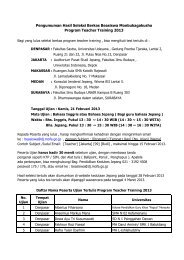9700_y16_sy
9700_y16_sy
9700_y16_sy
You also want an ePaper? Increase the reach of your titles
YUMPU automatically turns print PDFs into web optimized ePapers that Google loves.
Cambridge International AS and A Level Biology <strong>9700</strong> <strong>sy</strong>llabus Syllabus content<br />
AS Level Syllabus content<br />
1 Cell structure<br />
All organisms are composed of cells. Knowledge of their structure and function underpins much of<br />
biology. The fundamental differences between eukaryotic and prokaryotic cells are explored and provide<br />
useful biological background for the section on Infectious disease. Viruses are introduced as non-cellular<br />
structures, which gives candidates the opportunity to consider whether cells are a fundamental property<br />
of life.<br />
The use of light microscopes is a fundamental skill that is developed in this section and applied<br />
throughout several other sections of the <strong>sy</strong>llabus. Throughout the course, photomicrographs and electron<br />
micrographs from transmission and scanning electron microscopes should be studied.<br />
Candidates will be expected to use the knowledge gained in this section to solve problems in familiar and<br />
unfamiliar contexts.<br />
Learning outcomes<br />
Candidates should be able to:<br />
1.1 The microscope in cell<br />
studies<br />
An understanding of the<br />
principles of microscopy<br />
shows why light and electron<br />
microscopes have been<br />
essential in improving our<br />
knowledge of cells.<br />
a) compare the structure of typical animal and plant cells by<br />
making temporary preparations of live material and using<br />
photomicrographs<br />
b) calculate the linear magnifications of drawings,<br />
photomicrographs and electron micrographs<br />
c) use an eyepiece graticule and stage micrometer scale<br />
to measure cells and be familiar with units (millimetre,<br />
micrometre, nanometre) used in cell studies<br />
d) explain and distinguish between resolution and magnification,<br />
with reference to light microscopy and electron microscopy<br />
e) calculate actual sizes of specimens from drawings,<br />
photomicrographs and electron micrographs<br />
Back to contents page<br />
www.cie.org.uk/alevel<br />
17





